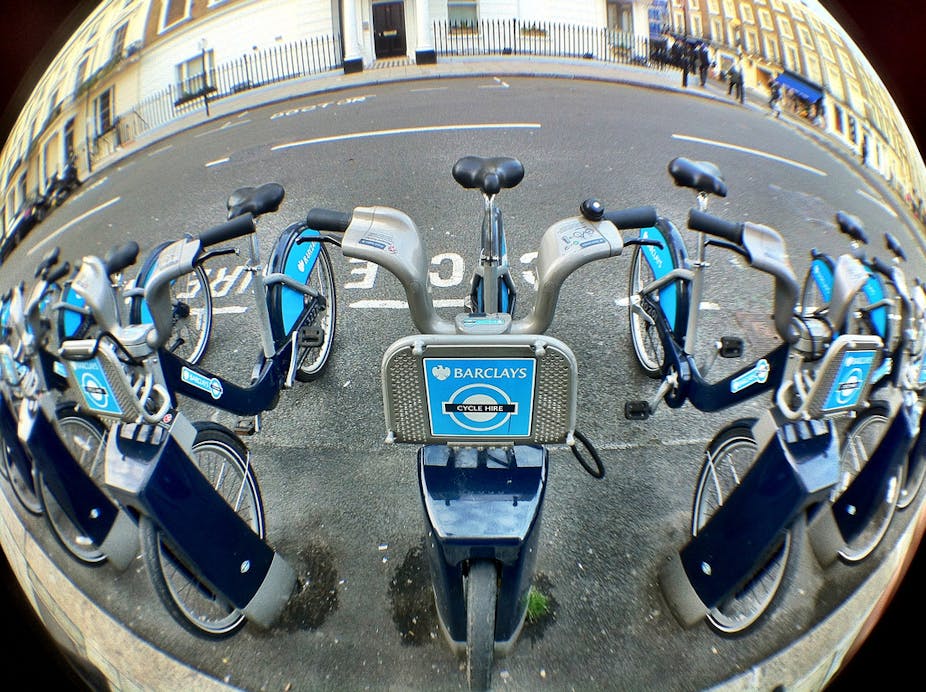Bike share programs in Melbourne and Brisbane were much heralded by the governments that installed them. But they’ve proved far less popular than schemes overseas. Is Australian bike share doomed?
Since 2005, public bike share programs have sprung up in cities in Europe, Asia and North America. Paris is perhaps the best known of the 300+ cities currently operating a public bike program, with over 20,000 bicycles. In China, Wuhan and Hangzhou have systems comprising 70,000 and 60,000 bikes respectively. New York City is set to launch the largest system in North America next March, with 10,000 bicycles.
There is growing enthusiasm for bike share. Various tracking and payment technologies are now available and affordable, so people can use the system with the swipe of a credit card. Public bike share growth is part of a wider interest in urban bicycling. Although coming from a low base, a large number of cities are experiencing significant growth rates in commuter bicycling. When used as a car replacement, bicycles are able to lower emissions, congestion, parking pressure and increase rates of physical activity.
Another, less publicised but no less potent reason behind the growth in bike share is the marketing benefit it offers. To many, bike share symbolises a sustainable, liveable urban culture. It says “we are a city that embraces change and rises to the challenge of climate change, traffic congestion and the need for clean air and healthy citizens”.

Implied in most of the benefits of bike share outlined above is an assumption that journeys taken on public bikes are substituting for motor vehicle travel. An examination of the evidence currently shows this is seldom the case. For instance, in Dublin, research¹ shows 66% of users previously walked. In London and Washington DC, only 1% of users report leaving the car at home.
It appears the vast majority of public bike users replace walking and/or public transport. While bike share programs in Europe, North America and China are heavily used, their success is limited by the degree to which they can attract people out of their cars.
Melbourne (Melbourne Bike Share) and Brisbane (CityCycle) have both had public bike programs since 2010, with approximately 600 and 1800 bicycles respectively. Usage has been lower than other cities and there has been widespread speculation about why this is the case.
Internationally, usage rates generally vary between three and eight trips per day per bike. In Brisbane and Melbourne usage has generally been within 0.3–0.4 and 0.4–0.8 trips per day per bike respectively. Washington DC in January, when it is snowy and wet, has substantially more usage on its bike share scheme than Melbourne or Brisbane have in December.
A number of reasons help explain lower levels of bike share popularity in Australia. Focus groups in Brisbane said accessibility problems (the sign up process, helmets and docking station location) and safety issues reduced use². The lengthy sign up process doesn’t use instant access, credit card swipe procedures common elsewhere (including Melbourne). This might stifle the spontaneity typically thought to attract people to public bikes. The 10pm closing time (most are open 24/7) frustrated current members, who reported having to leave engagements early to check out a bike before the system closes for the night.

Having to wear a helmet is often seen as a barrier to bike share use; focus groups support that. As one participant said:
I think it’s safer to use them [helmets] riding around town. If there was some sort of special bicycle lane that was safer and we did not need to wear helmets, I think that would be okay.
Many focus group participants just don’t think to take a helmet with them, in case they’d like to bike share later. Brisbane City Council saw a significant increase in casual use once they began providing helmets with some of their bicycles.
There is little doubt rescinding helmet laws would boost bike share usage in Australia. However until the full population health/safety impacts have been carefully assessed, such a move may have unintended consequences.
In order to bring Australian bike share usage closer to international norms (short of removing helmet legislation) the following measures should be considered:
- substantial improvements to the bicycle lane/path network
- lower speed limits
- integration with public transport smartcard ticketing
- significant increase in docking stations and bicycles (particularly Melbourne)
- improved helmet availability.
Adopting these measures would improve not just the performance of Melbourne and Brisbane’s bike share programs, it would also provide a significant benefit to the sustainability of the transport system generally.
References
Murphy, H. (2010). Dublin Bikes: An Investigation in the Context of Multimodal Transport. MSc Sustainable Development, Dublin Institute of Technology, Dublin.
Fishman, E., Washington, S., & Haworth, N. (2012). Barriers and Facilitators to Public Bicycle Scheme Use: A Qualitative Approach. Awaiting publication in Transportation Research Part F-Traffic Psychology and Behaviour

